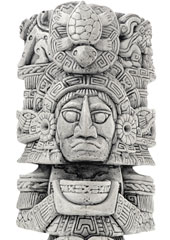Beyond the Mayan Calendar: Doomsdayism is Alive and Well
What are we to make of the strange social and cultural phenomenon of expectations of a worldwide calamity?
January 1, 2013

December 21, 2012 has come and gone, the Mayan “Long Count” calendar has rolled over, and the world as we know it persists. There was no apocalypse, no pole shift, no rendezvous with a mysterious “planet Nibiru.” What are we to make of this strange social and cultural phenomenon of expectations of worldwide calamity?
For many, the notion of the end of the world was an excuse for levity (“Buy Christmas presents? Why bother?”). It seemed like high comedy. But unfortunately for some, the macabre expectations and fears were all too real.
NASA fielded inquiries from teenagers and adults who were distraught, panicked, and even suicidal on account of the supposed ancient Mayan predictions. According to the pollsters at Ipsos, a survey of over 16,000 people in 21 countries revealed that fully 10% believed that the ancient Mayans predicted the end of the world in 2012, and 8% admitted experiencing anxiety or fear on that account.
What are we to make of this?
To put the 2012 episode in perspective, we must remind ourselves that end-of-world beliefs are nothing new. For nearly 3,000 years, people have been holding their breath and cringing before a final blow that never arrives.
Credit for inventing this curious and unnatural phenomenon goes to the ancient Persian prophet Zoroaster. Zoroaster invented the idea of a cosmic force of evil at large in the world, opposed to a cosmic force of good.
War between good and evil demands a climactic battle, which in turn requires a happy resolution, with old scores settled and blessed rest for the virtuous (that is, the pious followers of Zoroaster), while the wicked undergo eternal torment.
Ancient Jews freed from their Babylonian captivity by the Persians brought this suite of ideas with them to Jerusalem. They grafted it onto the traditional Hebrew religion. From there, it spread wherever the Old Testament was read.
Jesus tried to discourage morbid curiosity about the timing and details of the final catastrophe among his disciples, but he couldn’t stop later devotees from inserting a book of Revelation into the Christian canon.
When the prophet Muhammad found a group of his own followers debating the timing of the end of the world, he provided them with a helpful list of ten signs to watch for.
Apocalyptic thinking blossomed in the Middle Ages. And nearly every generation since then has had some prophet or other predicting imminent doom or salvation.
Columbus thought his voyages were fulfilling predictions in Revelations and ushering in the end of days. Thomas Müntzer led a peasant rebellion in sixteenth-century Germany that ended in grisly annihilation but not the expected apocalypse. Many of the English Puritans who colonized America in the seventeenth century and fomented civil war at home thought they had the millennium, 1,000 years of peace and prosperity before Judgment Day, within their grasp.
When European religion became more “rational” in the enlightened 18th century and materialistic 19th century, secular thinkers stepped in to fill the void. The socialist Charles Fourier speculated that the oceans would soon lose their salt and turn to lemonade. Karl Marx predicted a workers’ paradise and a stateless society. If the 20th century saw an uptick in religious apocalyptic fervor, this could be seen as just a return to the status quo.
Thus, the “Mayan 2012” apocalypse can be seen as merely one more installment in an ancient and venerable tradition of failed predictions.
What makes the recent episode unique is two-fold. First, it was a truly global phenomenon. Authorities in China and Russia had to make official statements to calm public fears.
Communities in France and Turkey near alleged “safe spots” were overrun by paranoid fanatics and gawking tourists. A mayor in Brazil urged his constituents to stock up and prepare for the worst.
This is testament not only to the influence of Hollywood (with its 2009 blockbuster disaster movie 2012 and the stealth marketing campaign that preceded it), but also the sheer power and dynamism of the Internet and social media in a globalized world.
Second, this is perhaps the first major case of “New Age” apocalyptic fever, based on a blend of supposed ancient wisdom and garbled science (rather than, say, on mysteries propounded in the books of Daniel and Revelation).
Cultural dislocation and economic insecurity
Yet we must still ask: Why do end-of-world predictions catch on? What makes such fantasies compelling, and what kind of person finds them believable?
A basic condition for end-of-world beliefs is a worldview based on a story. Zoroaster couldn’t conceive an end to the world until he had envisioned a cosmic drama unfolding in human history.
Cultures that view time as cyclical, such as the Hindus and the ancient Greeks (and, we might note pointedly, the Mayans), are not as susceptible to apocalyptic thinking as cultures with strong creation myths and cultures that are not well grounded in natural cycles.
The ancient Jews were highly susceptible on both counts. They thought time had a distinct, purposeful beginning, and they made stern efforts to suppress remnants of the old fertility rites and nature-based spirituality they shared with most other ancient cultures.
We have inherited their legacy. Today’s globalized urban civilization is profoundly alienated from natural cycles, and while monolithic religious (and Marxist, etc.) stories-what post-modernists call “grand narratives”–no longer dominate our historical imagination, we are certainly used to thinking about history in terms of purpose and progress.
We can be even more specific about the risk factors for apocalyptic thinking. The British historian Norman Cohn pointed out that in the context of the Middle Ages, the groups most prone to apocalyptic thinking were the culturally dislocated and economically insecure.
These included artisans working outside the guild system and peasants rocked by the break-up of the manorial system.
Cohn has often been misunderstood as attributing apocalyptic thinking to the poor and oppressed. This is not quite the same thing. It was not oppressed serfs who clamored for the end of the world in the Middle Ages. Rather, it was their grandchildren, former serfs set adrift in a world that no longer required them as a link in the Great Chain of Being.
This explanation rings true. It may be those who are unable to imagine a convincing future for themselves — whether for personal, economic or cultural reasons — in the world they inhabit, must perforce imagine something else, whether with dread or hope.
It certainly rings true, for example, in the case of the Ghost Dance fever that swept the Plains Indians in the late 1800s. When they could no longer fight or run, many of the surviving Plains Indians fell back on the desperate conviction that the white man’s world was merely an elaborate set dressing that would fall over of its own accord. In a flash, the old way of life would be restored.
Does this explanation hold for believers in the Mayan prophesies of 2012? It is certain, at least, that the economic dislocations of an increasingly globalized economy and a global recession have left many at a loss to imagine a convincing future for themselves and their families.
In China, Ipsos found that rates of belief in the alleged Mayan prophesies were as high as 20%, far and away higher than in any other country polled. This could reflect unsophisticated consumption of electronic media in China. It could also reflect the huge psychological effects of the recent breakneck pace of social and economic change in China, the lack of a social safety net, and erosion of confidence in the dominant (Communist) historical narrative.
Leaders of the mystical revolutionary Chinese Boxer and White Lotus movements of earlier centuries would have found the Mayanists’ 20% ideological alignment enviable. It is hardly any wonder that the Communist regime has cracked down on the Mayan cult.
If this understanding is correct, there is every reason to believe that we have not seen the end of global end-times fads in the 21st century. There is no end in sight to economic dislocations and cultural collisions in our globalized world. And we have food shortages, peak oil, and conflicts over water to look forward to.
While only 8% of those polled by Ipsos felt anxiety about the Mayan prophesies for 2012, fully 14% said they expect the world to end within their lifetime.
The dangers of apocalyptic thinking
Should we be concerned about apocalyptic beliefs and apocalyptic cults? The dangers to the public were perhaps overhyped this time around.
One NASA representative expressed concern about survivalists with stockpiled guns and ammunition getting panicked and trigger-happy as December 21 approached. Not missing a beat, a commercial end-times website took the opportunity to remind its readers that even if the Mayans were wrong, the threat of deranged, armed survivalists is another good reason to stock up on survivalist merchandise.
But even this time around, the costs were real: in psychological distress, in suicides (at least one confirmed in the United Kingdom), in distracting public officials and scientists from their proper business, in maintaining public order.
There were hundreds of arrests in China. Russians summoned a priest to calm a mass psychosis at a women’s prison, and police in Brazil and Argentina obstructed planned mass suicides.
Arguably, the Mayan 2012 episode was relatively benign. The prophesies didn’t demand that believers demonstrate publicly, or harm themselves, or persecute scapegoats. There is no guarantee that future episodes will be similarly benign.
Is there anything that can be done to mitigate future episodes of end-time hysteria? Social safety nets, sound environmental and trade policies, good governance, the principle of subsidiarity — any and all measures to give people confidence in and power over their own future may help.
Another important palliative is a good grasp of history. If we understand just how many predictions of end-times have been made and proved wrong in the past, and give some thought to how our own children will judge us for our own actions, we may be more likely to exercise greater skepticism the next time around.
In this sense, end-time beliefs are something like chain mail. Bogus and misguided petitions that circulated at the dawn of the Internet age are still circulating today. There are always new users who are not yet savvy enough to recognize a hoax.
If those who turned to NASA for help and guidance in 2012 are a representative sample, it appears that teenagers — inexperienced in the ways of the world — may be among the most vulnerable to end-times panic. Prophylactic education may be needed.
But even with the best education and preparation, end-time beliefs are likely to continue to resurface as long as we live in dynamic urban societies. I’ll hazard a prediction that world will fail to end many times over during the course of my lifetime.
Takeaways
The "Mayan 2012" apocalypse is merely one more installment in an ancient and venerable tradition of failed predictions.
What makes the recent episode unique is that it was a truly global episode.
Belief in Mayan prophesies may reflect the huge psychological effects of the recent breakneck pace of social and economic change.
End-of-world beliefs are nothing new. For nearly 3,000 years, people have been waiting for a final blow that never arrives.
End-time beliefs are likely to continue to resurface as long as we live in dynamic urban societies.
Read previous
Ranking U.S. Income Inequality
December 31, 2012
